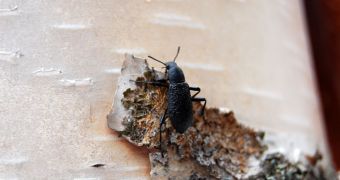Animals and insects living at the highest latitudes, either at the North or South Poles, had to be evolutionarily prepared to do so, biologists hypothesized a long time ago. They also proposed that these animals, especially the smaller ones, must have antifreeze molecules inside their bodies, to prevent the water inside them from expanding, as the liquid does when it freezes. Until now, these molecules remained elusive, but, recently, a species of Alaskan beetles gave up the secret, the US National Science Foundation (NSF) reports.
The new investigation was funded by the NSF, and conducted by scientists at the University of Notre Dame. The team was led by expert Kent Walters, and the detailed results have already been published, in the November 24 issue of the journal Proceedings of the National Academy of Sciences (PNAS). One of the most amazing things about the find is the fact that the molecule is not a protein, as scientists expected. Previously identified molecules that were thought to play a role in resistance to cold were all proteins, so the new study offers the first piece of evidence to the contrary. The molecule is actually a combination of saccharides and fatty acids, the team reports in the journal entry.
Though the exact size of the molecule has not yet been accurately established, the group believes that it must be fairly small. If this turns out to be true, than it could be a big plus. Researchers could easily synthesize small chains of sugars and fatty acids in the lab, as opposed to longer, more complex ones. The latter require a lot more work, as well as special conditions in order to turn out according to specifications. Commercial production will be made a lot easier, the scientists add, by the shorter chains. The less complex process would also entail a smaller cost.
The team also explains that antifreeze biomolecules can be found in a wide range of animals, from fish and insects to plants, fungi, and bacteria. “The most active known antifreeze proteins had been described in freeze-avoiding insects, allowing certain insects to survive temperatures below -60 degrees Celsius (-76 degrees Fahrenheit),” Walters explains. “Potential applications for this new class of antifreeze molecules are abundant. In terms of cryopreservation, we may be able to increase viability and enhance survivorship of cells and tissues from other organisms under freezing conditions,” he concludes.

 14 DAY TRIAL //
14 DAY TRIAL //